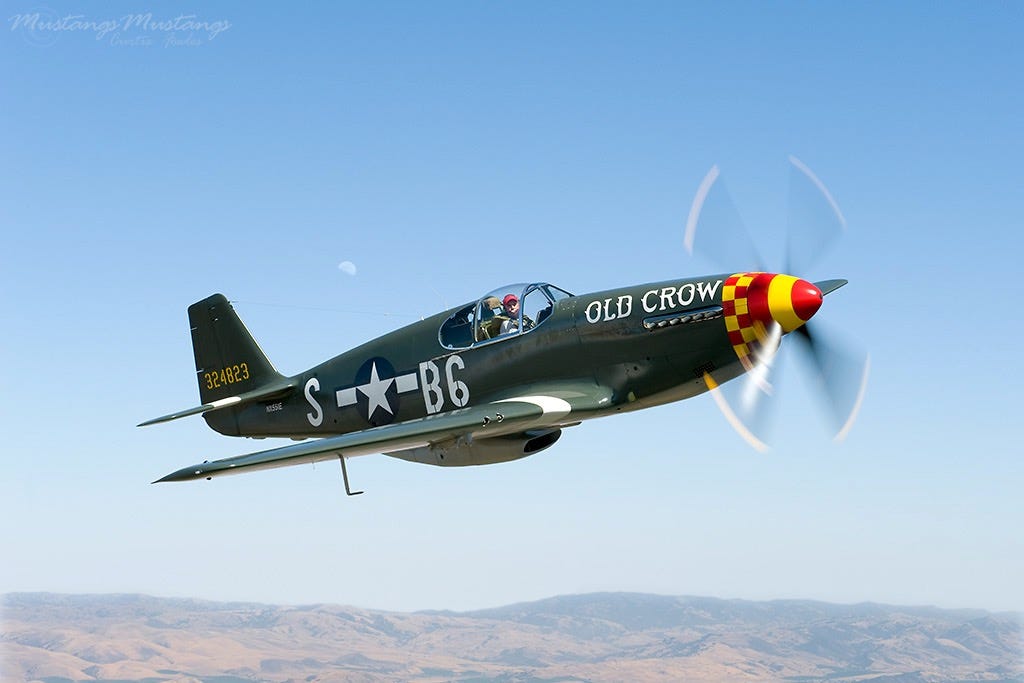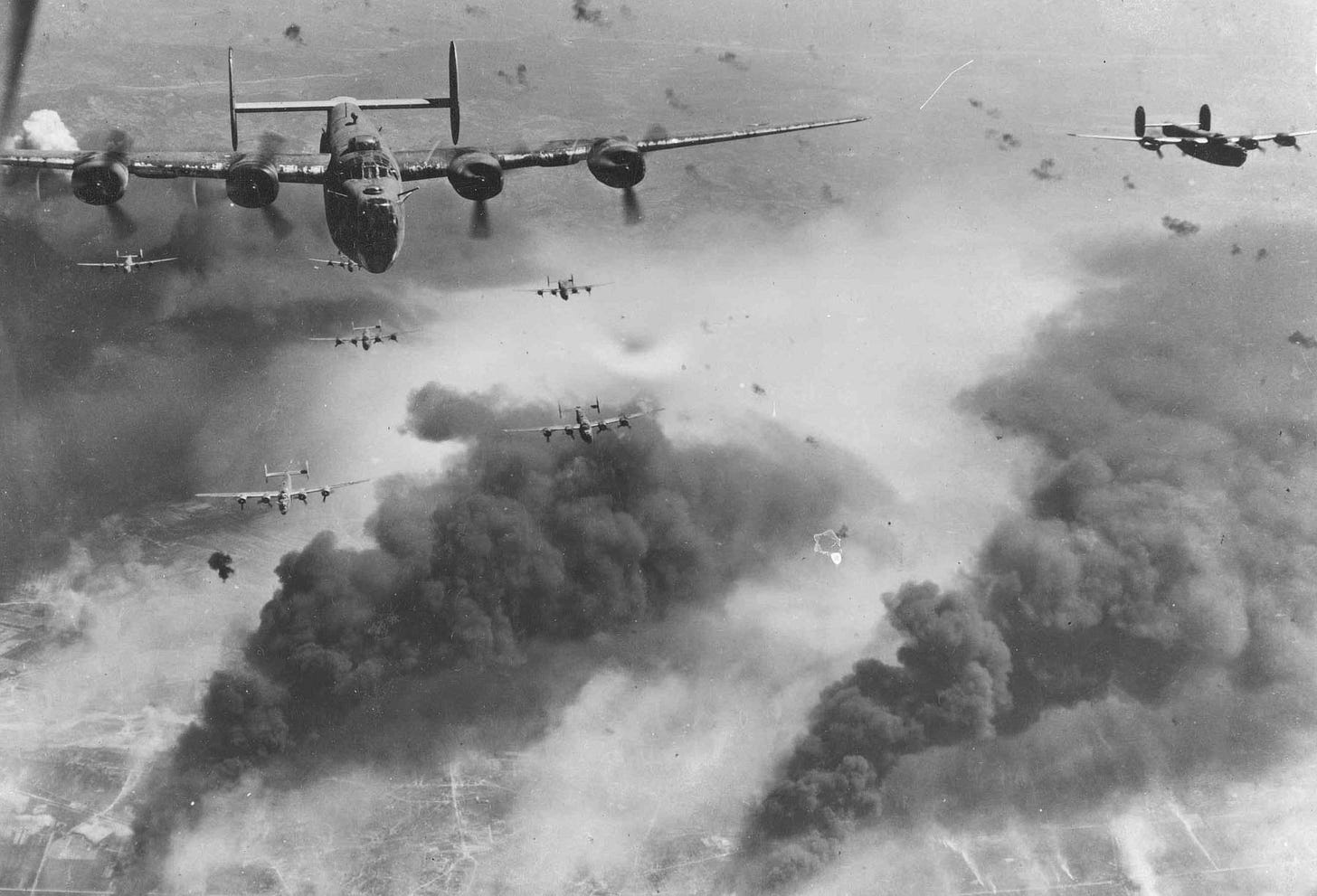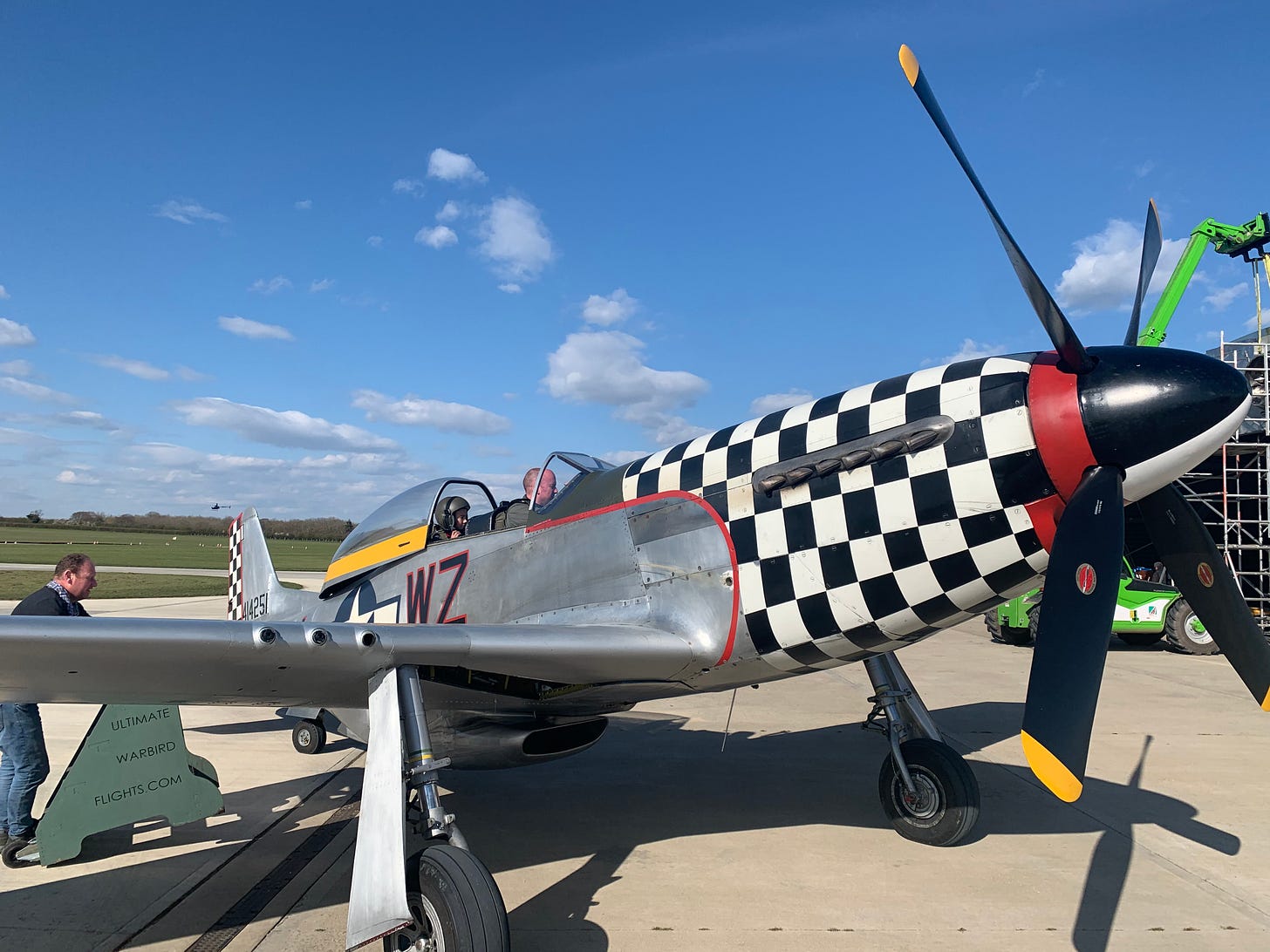THE MOST DECISIVE AIRCRAFT EVER BUILT
I’m going to put in a bold suggestion, not for the greatest, necessarily, but for the most decisive aircraft ever built – and by that, I mean the aircraft that has had the most impact. For me, it’s the P-51 Mustang.
I’d reached this conclusion some time ago but a couple of years ago I had the chance to go up in a two-seater converted P-51D. There’s an old adage about aircraft that if it looks right it probably is right, and the Mustang certainly looks the part: sleek but brawny, not the obvious beauty that is the Spitfire, but sturdier and infinitely more refined than a Thunderbolt or Hawker Typhoon. It also looks to be a generation further on in development from the early-war fighters and, as I have learned, certainly was so in construction, which made it easier to build and cheaper, which in a time of total war was a massive advantage.
In the air, it was wonderful: effortlessly agile, fast and rock solid. For a golden minute, I had ‘control’ and it barely batted eye despite my ham-fistedness. What a treat it was to experience.
Its origin story was an extraordinary one. In early 1940, Britain sent a delegtion to the United States to purchase more aircraft; at the time the US was neither at war nor under threat and had huge industrial potential. The delegation had been hoping to new buy fighters from the Curtiss-Wright Corporation but the US Army Air Corps was now dramatically expanding and Curtiss had their hands full. In desperation, the British delegation turned to the comparatively small North American Aviation company in Burbank, California. Initially, they asked North American to produce Curtiss Warhawks under licence but the comany’s president, James H. ‘Dutch’ Kindelberger, suggested they instead produce one of their own designs for the British instead.
Kindelberger knew that his chief designer, Edgar Schmued, a German-born engineer, had recently produced drawings for a brand-new fighter that very month, February 1940, and realised the British held the key to significant expansion for his fledgling company.
The British had been impressed and two months later, were presented with a more developed design of a fighter that looked sleek and smooth and included a revolutionary laminar-flow airfoil wing, which meant a much narrower leading edge and, theoretically, less drag; in a nutshell, the pressure that produced lift was more spread out than on a traditional wing. The fuselage, too, was narrower than on other fighters. Another design-first placed the radiator and oil-cooler intake centrally on the underside of the plane, just behind the cockpit, which not only reduced drag further but also produced a far more efficient cooling system. Further, and quite by accident, the radiator design created around 300 pounds of jet thrust as the heat energy left the scoop.
Schmued’s design was duly approved on 4 May 1940 with an order for 320 planes and astonishingly, the time from blueprint to first flight was a lightning-fast 117 days, an extraordinary achievement. It also spoke of the brilliance and simplicity of the design, all of which augured well for mass-production; the simpler it was to make, the easier and quicker it was to produce and with it cost per unit would also tumble.
Yet successful aircraft design was all about the marriage of airframe and engine and the Allison V-1710 proved disappointing, with performance tailing off the higher the altitude it flew. This was no good at all for a fighter, for which a rapid rate of climb and high performance at 25,000-35,000 feet was vital. The RAF duly took possession of their Mustangs but then relegated them to a ground-attack role. It had been a huge disappointment, especially since Schmued’s design had promised so much.
The Mustang might well have been relegated for ever had it not been for Ron Harker, chief test pilot for Rolls-Royce, who in October 1942, suggested trying equipping it with a Merlin engine. The latest version of this iconic power plant, the Merlin 61, had 1,565 horsepower compared with the Allison’s 1,150, but also a two-speed, two-stage supercharger. The Merlin was shorter in length than the Allison but with the supercharger added, Harker realized the two engines had very similar proportions; this meant the Merlin 61 could be fitted into the Mustang with no external design change at all.
With the Merlin 61 in place in the Mustang, Harker test flew it and discovered an astonishing transformation. At 10,000 feet, it could fly at 400 mph; 430 mph at 20,000, and at 35,000 feet a stunning 455 mph – 70 mph faster than a German Me109 or FW190 at such heights. It could dive faster than anything else and had a quicker rate of roll too. The marriage of Merlin and Mustang had totally transformed Schmued’s genius design.
Yet although Harker made this discovery back in the autumn of 1942, the new Merlin-powered Mustang remained in the shadows, its full potential yet to be realized in the skies over Europe. In the meantime, the Allies were facing a major crisis by the summer of 1943 despite a clear turn of fortunes in the war.
And this crisis was over Allied air power and specifically, how to win control over the skies over much of north-west Europe ahead of D-Day, Operation OVERLORD, at the time scheduled for May 1944.
The D-Day story tends to be told from the perspective of the landings and with men leaping from assault craft or floating down on parachutes, yet the air battle before hand was of critical importance to the entire operation. Why? Because the only way the Allies could successfully invade Normandy on D-Day was if they had control of the skies over much of north-west Europe. This was vital because the moment Allied troops landed in Normandy the cat would be out of the bag and then the race would be on as to which side could build up a decisive amount of men and materiel first. Would it be the Allies, who had to cross a hundred miles or more over the Channel in slow vessels, or would it be the Germans, who were alreay on the Continent? On paper, the Germans had a huge advantage, which was why it was essential the Allies hammered their lines of supply and made it as difficult and slow as possible for the enemy to supply the front.
This could be achieved by pounding German lines of communication: railway lines, marshalling yards, bridges and roads and also blinding them by destroying radar stations, airfields and ground control centres. However, hitting a bridge required pinpoint accuracy and this could only be done by flying very low with fast, twin-engine medium bombers. And this in turn could only be carried out so long as there were no enemy Messerschmitt and Fock-Wulfs hovering above them waiting to pounce.
Hence the need to clear the skies of the enemy. This plan was drawn up in the Operation POINTBLANK directive of early June 1943, a few weeks after OVELORD had been given the final green light. POINTBLANK made the destruction of the Luftwaffe the priority for Allied bombing operations. Heavy bombers would pound enemy aircraft factories while fighters would engage their counterparts either in the air or on the ground.
The problem, however, was one of geography. Much of Germany’s industrial heartland was in the west of the Reich, conveniently placed for Lancasters and Flying Fortresses operating from eastern England. This was not the case for the enemy aircraft industry, however; rather, Messerscmitt, Junkers and others all had aircraft production plants deep inside the Reich.
The American Boeing B-17 Flying Fortress and Consolidated B-24 Liberator had both been designed to operate by day, in tight box-formation, and each with 13 heavy .50 calibre machine-guns to protect them. A formation of, say, 350 heavies would collectively have 4,550 big machine-guns to protect them. Before the war, planners reckoned that would be plenty but the reality was proving very different. When 315 US Eighth Air Force heavies targeted aircraft industry targets at Regensburg and Schweinfurt on 17 August 1943, sixty were shot down - with all thier ten-man crews - a further 11 were subsequently scrapped and another 164 were badly damaged. It was a catastrophe.
So badly hit was the Mighty Eighth by this attack they could mount nothing like it again until October. In a subsequent week of operations against the German aircraft industry they lost a further 148 heavies shot down, including another sixty attacking Schweinfurt once more on 14 October. Losses of 20% of the attacking force meant that in five missions the entire air force’s heavy bombers would be destroyed. Such a rate of attrition was totally unsustainable.
Clearly, the pre-war ‘Bomber Men’ had been wrong: flying in defensive boxes with a collective mass of machine-guns did not offer sufficient protection. Rather, what was needed, and which had been standard practice well before the first Schweinfurt-Regensburg raid, was to provide the bombers with fighter escorts. Anti-aircraft guns - flak - firing from the ground below had just a 0.002% chance of a single shell hitting a bomber; by far the greatest danger to bombers came from attacking enemy fighter aircraft. Allied fighters, therefore, both kept the Luftwaffe’s fighters busy and shot them down in turn.
By the summer of 1943, it was realized with mounting panic that the Allies desperately needed a long-range fighter capable of escorting bombers deep into the Reich. The Americans, especially, who were committed to daylight operations rather than night time ops like RAF Bomber Command, were aware of this even before the ill-fated Schweinfurt-Regensburg Raid. General ‘Hap’ Arnold, commander-in-chief of the USAAF, had given the mission of finding a long-range fighter to his deputy, Lieutenant-General Barney Giles, in June 1943. ‘Within this next six months,’ Arnold had told Giles, ‘you have got to get a fighter to protect our bombers. Whether you use an existing type or have to start from scratch is your problem. Get to work on this right away, because by January ’44, I want fighter escort for all our bombers from UK into Germany.’ Crucially, he wasn’t giving Giles six months to find a solution but rather just half a year to get both the long-range fighter and have enough built and shipped to England to make the difference.
Time was of the essence. At the time, D-Day was scheduled by May 1944 and the skies needed to be clear of the Luftwaffe over north-west Europe in advance of the invasion. If they weren’t, OVERLORD was off. The stakes, then, could not have been higher.
Fortunately for General Giles and the Allies, however, the answer was sitting right in front of him. The Merlin 61 could be built in the US under licence by the Packard automobile company, while tests with extra fuel tanks, both incorporated into the airframe and with disposable ‘drop-tanks’ slung under each wing, meant the P-51 Mustang now had the range to fly not only to Berlin and back but as far as Warsaw. There was now no enemy aircraft plant out of range. And that was a game changer.
Although the solution lay in front of them, they now faced the difficulty of producing enough quickly enough. This was where American industrial muscle and speed of decision making really made itself felt. The United States was capable of mass-production but also of a very streamlined procurement and production cycle, essential in any modern conflict. Merlin-powered Mustangs reached the UK in November 1943 and first flew with the 354th Fighter Group in December 1943 and quickly made themselves felt. On 11 January 1944, for example, Major Jim Howard of the 354th found himself alone and protecting a returning formation of B-17s. Despite being outnumbered thirty to one, he shot down six enemy fighters and still managed to protect the bomber force; not one was lost. Howard was awarded the Medal of Honor for this action, the United States’ highest award for valour, but more importantly it proved what a truly outstanding aircraft the Mustang had become.
Mustangs reached the 4th Fighter Group in February 1944 and there on rapidly grew in number, with successive fighter groups either arriving with the P-51 or existing units seamlessly transitioning to this new war-changing aircraft. The Mustang played an increasingly critical role as the Mighty Eighth, especially, continued its mission to hammer the Luftwaffe. By mid-April, most of north-west Europe was cleared of enemy fighters; by the end of May 1944, by which time D-Day was due the following week, the closest Luftwaffe airfield was 500 miles from the planned invasion beaches, all the bridges across the River Seine had been destroyed, railway marshalling yards hammered, Luftwaffe factories pounded, and the skies clear. The impact of the P-51 to these operations was immense. As we all know, D-Day was a success, Normandy then France was liberated and then so too all of Western Europe.
The Mustang story has important lessons for today as Britain and her Western European allies face rearmament. Modern aircraft are substantially more complicated but were still complex beasts even in the 1940s. The Mustang followed the age-old rule of keeping a complex machine as simple as possible. It was significantly easier and cheaper to produce than any of its contemporaries. Those making decisions about what to produce today would do well to study its story; rapid decision making, cutting potential production hiccups, and the bringing together of basic design and power plant harmoniously will all be critically important as Britain and others look to increase defence production.
After my flight, my thirteen year-old daughter was taken for a spin – lucky girl – and watching her hurtle over the airfield then climb into a victory roll I marvelled anew at this stunning little aircraft. Racking my brain, I still couldn’t think of a single aircraft that has had a greater impact than the P-51 Mustang. It’s the most decisive aircraft. Ever.








As a boy I eventually collected and built over 200 plastic model airplane kits, but the Spitfire still held my heart as the most beautiful airplane possibly ever. It was only when I got older and was able to see and hear the actual surviving planes that I feel in love with the sound of the Merlin engine. Some years ago I was mowing my backyard while listening to a local rock and roll station through my earbuds. And yet over the sound of the small gasoline engine and the blaring of rock guitars and drums I heard that sound. I stopped the mower, pulled out the earbuds, and ran around the house to the street in front where there was a better view of the sky - in time to see not one but two P51 Mustangs flying past (living in the Washington DC suburbs with Arlington Cemetery and the Smithsonian Air and Space Museum this kind of thing actually happens). A few years later I was walking away from the Reading Pennsylvania WW2 weekend when I spotted the P51 and the two Lancasters plus a B17 on the taxiways so I planted myself in line with the main runway beyond the fence line but directly underneath their expected flight path so I could bathe in that sound.
Let’s stipulate that the P-51/Mustang (an ubergeek told me they were “actually” different aircraft, something about the undercarriage. I have no idea) was an outstanding war winning machine. No doubt at all. However, Jim, no Hurricane/Spitfire combo in the Battle of Britain, no need for NAA’s finest. I would respectfully suggest that is the greater impact. There is no question that the P-51 went on to be the more decisive aircraft in a role for which it was well suited. The question I have is why nobody thought to fit drop tanks to Spitfires? Or did they and it wasn’t successful.